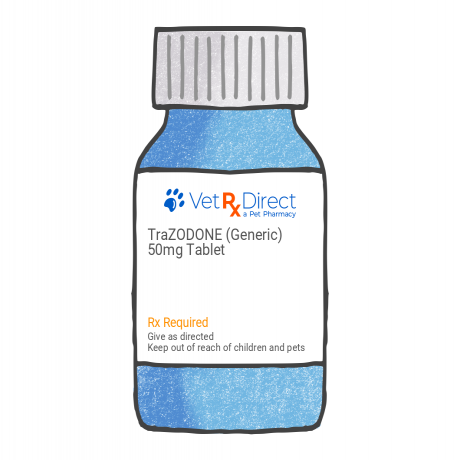Trazodone is an atypical antidepressant sometimes prescribed by veterinarians for dogs. While not formally approved by the FDA for veterinary use, trazodone provides several therapeutic effects that may benefit anxious, stressed, or insomniac dogs when given at the appropriate dosage.
This article will cover common uses of trazodone for dogs, typical dosage by weight, potential benefits, and side effects to be aware of. Always consult your vet before giving your dog any new medication.
What is Trazodone?
Trazodone belongs to a class of drugs called serotonin antagonists and reuptake inhibitors (SARIs). It works by blocking serotonin receptors and increasing serotonin levels in the brain.
While trazodone is used as an antidepressant in humans, it has additional mechanisms that make it useful for veterinary applications:
- Anxiolytic (anti-anxiety) effects
- Sleep aid (hypnotic) properties
- Mild pain relief (analgesic) action
- Antiemetic (anti-vomiting) effects
- Minimal motor impairment
Due to this range of benefits, veterinarians often prescribe trazodone for dogs struggling with anxiety, insomnia, nausea, and pain.

Trazodone Dosage for Dogs by Weight
Trazodone dosage is based on your dog’s weight and is administered 1-3 times per day. The typical dosing guideline is:
- Under 10 lbs: 25-50 mg
- 10-25 lbs: 50-100 mg
- 25-50 lbs: 100-200 mg
- Over 50 lbs: 200-300 mg
Dogs metabolize trazodone rapidly so splitting the total daily dose into 2-3 increments optimizes therapeutic effects.
Always start with the lowest effective dose based on your dog’s weight and monitor for desired results and side effects. Increase gradually if needed under your vet’s guidance.
Extended-release trazodone tablets can allow once or twice daily dosing for convenience. Liquid forms can aid accurate dosing for small dogs.
What is Trazodone Used for in Dogs?
While not FDA approved for animals, vets prescribe trazodone for several “extra-label” uses in dogs:
Anxiety Treatment
Trazodone has anti-anxiety properties making it useful for generalized anxiety, phobias, and separation anxiety. It can be combined with behavior modification training.
Sleep Aid
The sedating effects of trazodone help induce sleep in dogs with insomnia or disrupted sleep-wake cycles. However, drowsiness may persist into the next day.
Inappetence Stimulant
Improving appetite and preventing nausea are additional benefits of trazodone. The drug may help dogs with inappetence resume normal eating.
Pain Management
At prescribed doses, trazodone provides mild analgesic effects which can supplement NSAIDs or other medications in multi-modal pain control regimens.
Sedation
Trazodone’s calming action is useful for short term sedation during stressful events like thunderstorms, vet visits, or grooming.
Behavioral Issues
For compulsive disorders like demisexuality, tail chasing, fly biting, or licking, trazodone combined with training helps disrupt obsessive behaviors.
Always discuss with your vet first before giving trazodone to decide if it’s appropriate for your dog’s issues. Follow their dosage recommendations closely.

What are the Benefits of Trazodone for Dogs?
Potential benefits of trazodone for dogs include:
- Reduces anxiety and stress behaviors.
- Induces sleep and treats insomnia.
- Stimulates appetite in inappetent dogs.
- Provides mild pain relief allowing lower doses of other analgesics.
- Prevents vomiting and nausea.
- Sedates without excessive motor impairment.
- Disrupts compulsive behavioral patterns.
- Fewer side effects than some other sedatives.
- Less potential for abuse than benzodiazepines.
- Allows dose adjustments tailored to individual response.
Trazodone works rapidly providing therapeutic effects within 1-2 hours. Effects wear off within 8-12 hours minimizing hangover sedation. It can be used for both acute and chronic issues.
What are the Side Effects of Trazodone in Dogs?
While often well tolerated, potential trazodone side effects in dogs may include:
- Excessive sedation or lethargy
- Disinhibition (behavioral agitation)
- Hyperactivity
- Panting
- Vomiting or diarrhea
- Constipation
- Trentally (head bobbing)
- Liver toxicity (rare)
To minimize risks:
- Accurately dose by weight
- Administer the lowest effective dose
- Split doses rather than one large dose
- Closely monitor the first few days
- Avoid combining with other drugs without vet approval
Immediately call your vet if abnormal reactions occur. Most effects resolve within 24 hours once trazodone is discontinued.

Is Trazodone Safe Long-Term for Dogs?
There are no official long-term studies on prolonged trazodone use in dogs. Potential concerns with chronic use include:
- Tolerance developing requiring higher doses
- Serotonin syndrome if combined with other serotonergic drugs
- Increased risk of side effects
- Potential cardiac arrhythmias
- Liver toxicity is rare but more likely with extended use
Work closely with your veterinarian if trazodone needs to be given longer than 2-4 weeks continuously. Follow up with bloodwork to monitor organ function and watch closely for adverse effects.
Trazodone for Dogs: The Bottom Line
Under veterinary supervision, trazodone can provide therapeutic benefits for many canine behavioral and health conditions. However, inappropriate dosing of trazodone for dogs can be hazardous. Starting low and gradually increasing the dose based on response minimizes risks.
Use the lowest effective trazodone dose for your dog’s weight and keep in close contact with your vet, especially for long-term use. With prudent use, trazodone can significantly improve comfort and quality of life for anxious, stressed, and insomniac dogs.



